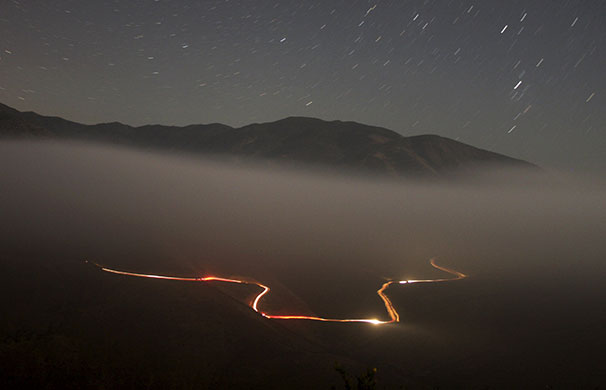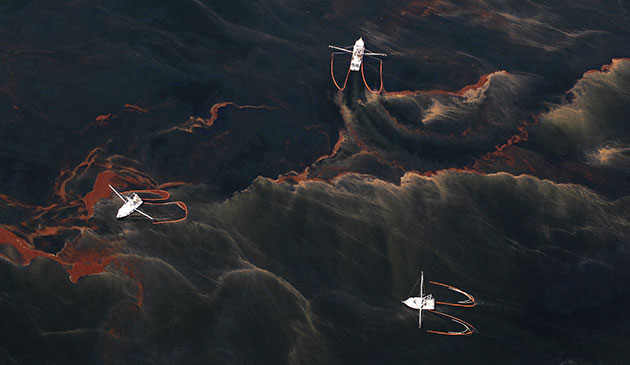
Don’t ask what it is, just enjoy it for a moment. Earth and stars, a soft layer of cloud and a bright river of light–the scene is both timeless and transitory. The stars wheel across the sky as night turns toward day, and the mountains will keep their deep geological time while that strip of illumination flares for an instant and then is gone. Perhaps it’s a line of fire, more likely something human and so even more impermanent. One can imagine the stars slowly fading out and the universe sinking into final darkness, yet planet and sky would still be part of the same unity.
But if your fate were tied to that light snaking through the darkness, you might wonder just what it is. The answer is, a US border patrol vehicle travelling near Otay Mountain, on the outskirts of San Diego, California. I don’t know enough about the area to say whether the vehicle is following the border exactly, but the time-lapse photograph nonetheless becomes an image of how the state draws a line in an otherwise inchoate reality. In place of the deep regularities of nature, here we see a division that could just as well be drawn a thousand different ways.
That assertion of sovereignty seems mighty puny against the galaxies passing overhead, but it is closer to human scale, for better or worse. It also is not inconsistent with the world around it: the trail will be following the contours of the landscape, and its light and shape mirror the landform and firmament in the background. What is inescapable, however, is that the patrol can only be a momentary traversing of a much bigger reality.

Like this, for example. Now you are looking at shrimp boats dragging booms to collect oil in the Gulf of Mexico. Like the border patrol, they, too, are drawing lines in the dark. The effort to capture some of the oil has to be undertaken, but any attempt to capture all of it is surely futile. This is not a brief against the state, however. The boats probably are working for British Petroleum, but it is not likely they would be working at all if the US government wasn’t able and willing to enforce some corporate compliance with environmental protection. Modern societies need to have states, and states are defined by borders, so what is the point?
These photographs are not images of trucks or boats or even of their visible traces in the darkness of a desert night or the deep waters of the Gulf. These images are hieroglyphs of human limitation. They mark the enormous difference between human–and, yes, modern–activity and the natural world encompassing it. They remind us that large scale collective enterprises–states and corporations–are nonetheless very partial, incomplete attempts to manage a world that remains too often inchoate and beyond control. In short, these images declare that we are overmatched–and not only by natural forces but by our own attempts to live well at all.
And for all that, they are beautiful. Some would say that is a liability, but I think it’s a clue. Even when working through the stupidities that define US immigration policy (too much policing) and regulation of the oil industry (too little), the hints of more harmonious relationships are there to be seen. The societies that need to be developed will always involve drawing lines in the dark, but perhaps they will make more sense if they are undertaken with a sense of humility, and with the idea that beauty need not be accidental.
Photographs by Jorge Duenes/Reuters and Eric Gay/Associated Press.
Go another step further than “… we are overmatched–and not only by natural forces but by our own attempts to live well at all.” and the question becomes who are the we that are overmatched? And what do we mean by living well? With only a slight shifting of the internal gears comes the idea that no matter how bag-ugly things get, there’s always the good-beautiful, what I call “found art.” These two images are examples.
[…] Robert Hariman refers to abstracted images of border patrol lights and oil slick swirls as the “hieroglyphs of human limitation”. […]
Lovely post Robert.
I don’t understand how such superb photographs are found art. They didn’t just turn up unaided, like a number 20 bus.
Maybe what I’m calling found art doesn’t turn up unaided like a number 20 bus for everybody at least one a day turns up for me.
In fact, I believe there’s always at least one somewhere within my visual field, whether I am aware of it depends on my state of mind.
Naturally they don’t come ready-made, you need to fool around with the angle, the framing, the exposure both during the shoot and during the photoshopping.
Rounding up people from Mexico and rounding up unwanted oil from the Gulf of Mexico. Hmm. A lot of comparisons could be made here along the lines of energy, work, industry, and how some things are desirable and convenient when they can be controlled, kept in check, and properly exploited, but when allowed to flow freely, people get nervous and unhappy.
Or, we could just simply label these “Foreign Countries Messing Up America.” Works for me!